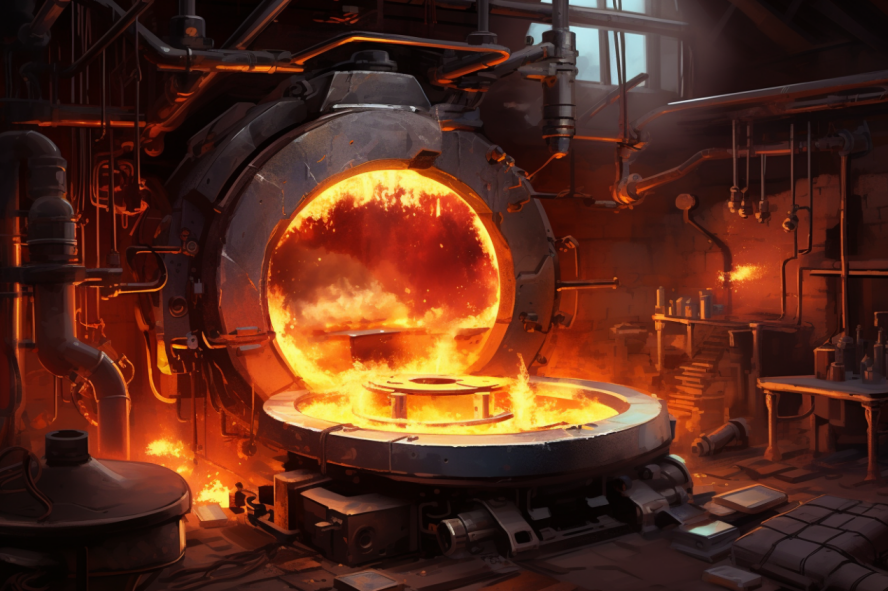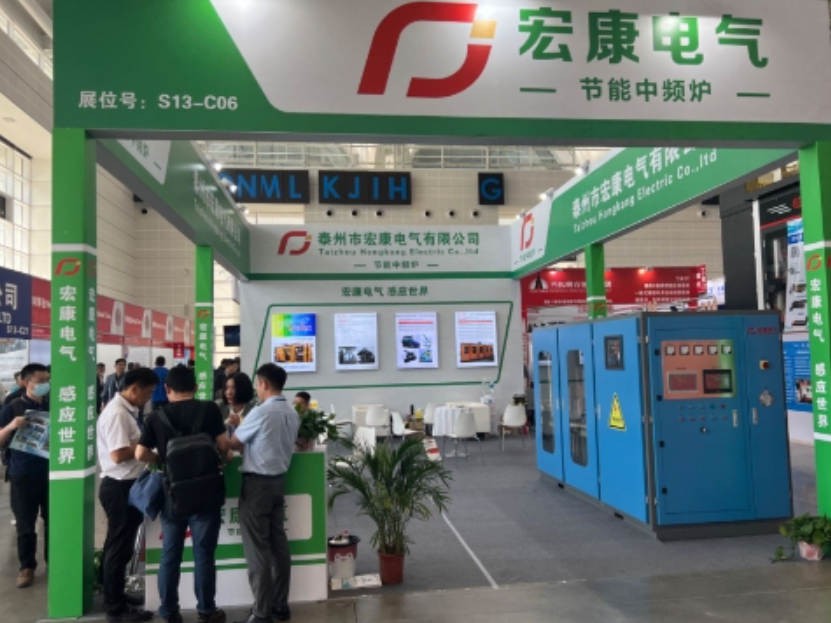The Role of Medium Frequency Furnaces in Modern Industry
Explore the efficiency and versatility of Medium Frequency Furnaces, along with key considerations and maintenance guidelines. Trust Taizhou Hongkang Electric Co., Ltd. for premium furnace solutions tailored to your requirements.
Introduction to Medium Frequency Furnace
Medium Frequency Furnaces (MFFs) are advanced heating systems widely employed in various industries for their efficiency and versatility. These furnaces operate within the medium frequency range, typically between 1 kHz and 1 MHz, offering precise control over heating processes. With their ability to generate high temperatures quickly and uniformly, MFFs have become indispensable tools in modern manufacturing processes.
1. What is Medium Frequency Furnace?
Medium Frequency Furnace utilizes electromagnetic induction to generate heat within a conductive material. They consist of a power supply, coil, crucible, and cooling system. By passing alternating current through the coil, a rapidly changing magnetic field is created, inducing eddy currents within the material placed inside the crucible. These currents produce heat through resistance, allowing for efficient heating of various materials.
2. Overview of Applications
Medium Frequency Furnaces find extensive applications across industries such as metal casting, heat treatment, and induction melting. Their ability to deliver precise and controlled heating makes them ideal for processes requiring uniform temperature distribution and rapid heating cycles.
3. Basic Working Principles
The primary advantage of Medium Frequency Furnaces lies in their efficient heating process. Unlike traditional furnaces, which rely on conduction or radiation for heat transfer, MFFs utilize electromagnetic induction. This results in faster heating rates and reduced energy consumption. Additionally, MFFs offer precise temperature control, minimizing the risk of overheating or underheating materials.
Key Components of a Medium Frequency Furnace
Medium Frequency Furnace comprises several key components, each playing a crucial role in the heating process.
1. Power Supply
The power supply is the heart of the Medium Frequency Furnace, converting alternating current from the mains into the high-frequency current required for induction heating. It regulates the frequency and amplitude of the current, ensuring optimal performance and efficiency.
2. Crucible
The crucible serves as the container for the material being heated. It is typically made from materials such as graphite or ceramic, capable of withstanding high temperatures without deforming or reacting with the contents. Crucibles come in various sizes and shapes to accommodate different materials and heating requirements.
3. Coil
The coil, also known as the inductor, is responsible for generating the electromagnetic field used for heating. It is wound around the crucible and connected to the power supply. The design and configuration of the coil determine the distribution of heat within the material, making it a critical component for achieving uniform heating.
4. Cooling System
The cooling system prevents overheating of the furnace components and ensures continuous operation. It typically consists of water-cooled coils and channels that dissipate heat generated during the heating process. Efficient cooling is essential for maintaining the longevity and performance of the furnace.
Applications of Medium Frequency Furnace
Medium Frequency Furnace is widely utilized across various industries for their versatility and efficiency in heating processes.
1. Metal Casting
In metal casting, Medium Frequency Furnaces are used for melting and pouring metals into molds. Their rapid heating capabilities allow for quick melting of metals such as iron, steel, and aluminum, enabling efficient production processes in foundries and manufacturing facilities.
2. Heat Treatment
Medium Frequency Furnace is also employed in heat treatment processes, such as annealing, tempering, and quenching. Their precise temperature control and uniform heating make them ideal for achieving desired material properties, such as hardness and toughness, in metal components.
3. Induction Melting
Induction melting is another common application of Medium Frequency Furnaces, particularly in the production of alloys and specialty metals. By selectively heating the material within the crucible, MFFs enable precise control over alloy compositions and melting temperatures, ensuring consistent quality in the final product.
Advantages and Disadvantages of Medium Frequency Furnace
Medium Frequency Furnace (MFF) offers several advantages over other types of furnaces, but they also come with some limitations.
1. Advantages
Medium Frequency Furnace is known for its high efficiency and rapid heating capabilities. Compared to traditional furnaces, MFF can achieve higher temperatures in a shorter amount of time, leading to increased productivity and reduced energy consumption. This efficiency is particularly advantageous in industries where time-sensitive heating processes are common, such as metal casting and heat treatment.
Flexibility is another key advantage of Medium Frequency Furnaces. They can be easily adjusted to accommodate different materials, shapes, and heating requirements. The ability to control heating parameters such as temperature, heating rate, and holding time makes MFFs versatile tools for a wide range of applications.
In terms of cost-effectiveness, Medium Frequency Furnaces offer significant savings in the long run. While the initial investment may be higher compared to some other furnace types, the energy efficiency and productivity gains provided by MFFs often result in lower operating costs over time. Additionally, the versatility and flexibility of MFFs can lead to reduced setup and changeover times, further enhancing cost-effectiveness.
2. Disadvantages
Despite their numerous advantages, Medium Frequency Furnace do has some limitations. One potential drawback is the initial investment cost, which can be higher compared to traditional resistance or gas-fired furnaces. The need for specialized equipment such as power supplies and cooling systems adds to the upfront expenses associated with MFFs.
Another limitation of Medium Frequency Furnaces is their reliance on conductive materials for heating. While MFFs excel at heating materials such as metals and alloys, they may not be suitable for non-conductive materials or materials with low magnetic permeability. This can restrict their applicability in certain industries or specific heating processes.
Factors to Consider When Choosing a Medium Frequency Furnace
When selecting a Medium Frequency Furnace for a specific application, several factors should be taken into account to ensure optimal performance and compatibility.
1. Power Capacity
The power capacity of the furnace determines its heating capabilities and throughput. It is essential to choose a furnace with sufficient power output to meet the heating requirements of the intended application. Factors such as the size and composition of the materials being heated will influence the required power capacity.
2. Frequency Range
The frequency range of the furnace affects its heating efficiency and penetration depth. Higher frequencies typically result in faster heating rates and shallower penetration, while lower frequencies provide deeper heating. The optimal frequency range depends on the material properties and heating objectives of the application.
3. Coil Design
The design of the induction coil plays a crucial role in determining the distribution of heat within the material. Different coil configurations, such as single-turn, multi-turn, or pancake coils, offer varying levels of heating uniformity and efficiency. The coil design should be selected based on the specific heating requirements and geometry of the materials being processed.
4. Control Systems
The control system of the furnace governs the heating parameters and process variables. Advanced control systems allow for precise temperature regulation, heating profiles, and automation of heating cycles. When choosing a Medium Frequency Furnace, it is important to consider the capabilities and features of the control system to ensure optimal performance and ease of operation.
Maintenance and Troubleshooting of Medium Frequency Furnace
Proper maintenance is essential to ensure the continued performance and longevity of a Medium Frequency Furnace. Regular maintenance tasks should be performed to prevent issues and minimize downtime.
1. Regular Maintenance Tasks
Routine maintenance tasks for Medium Frequency Furnaces may include inspecting and cleaning the induction coil, checking coolant levels and flow rates, inspecting electrical connections, and lubricating moving parts. These tasks help prevent the buildup of debris, corrosion, and mechanical wear that can compromise furnace performance.
2. Troubleshooting
Despite regular maintenance, issues may still arise during the operation of a Medium Frequency Furnace. Common problems such as overheating, coil damage, or electrical faults may require troubleshooting and repairs. It is important to have a thorough understanding of the furnace components and operation to identify and address issues promptly.
3. Maintenance Strategies
Depending on the complexity of the maintenance tasks and the availability of resources, maintenance activities can be performed internally by trained personnel or outsourced to professional service providers. Outsourcing maintenance tasks may be beneficial for complex repairs or specialized services, while internal maintenance can help reduce costs and downtime for routine tasks.
Conclusion
Medium Frequency Furnace represents a significant advancement in heating technology, offering efficient and precise heating solutions for various industrial applications. With their ability to generate high temperatures quickly and uniformly, MFFs have become indispensable tools in metal casting, heat treatment, and induction melting processes. As industries continue to demand greater efficiency and precision in their manufacturing processes, Medium Frequency Furnaces are poised to play a crucial role in meeting these requirements.


